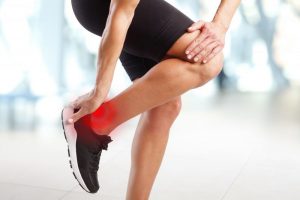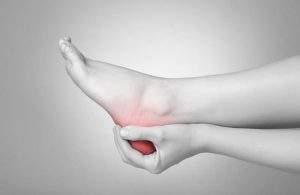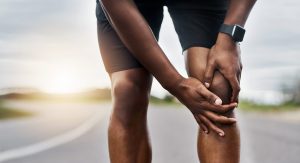Running is one of the most accessible and versatile sports around. All you have to do is get some running shoes, get out in the fresh air and start running. The benefits to the body and mind are unquestionable. But you have to be careful, because we often don’t pay enough attention to our body’s signals and run the risk of getting a typical runner’s injury.
In this article, we present the most common injuries to runners and briefly explain how to prevent and treat them. For this purpose we had the opportunity to exchange a few words with Luca Noti (member of the Swiss national running team and recently recovered from “runner’s knee”).
Running injuries are unfortunately a relatively common problem. With each stride, the feet absorb 2.5 times the body weight at impact. Injuries are often due to inexperience, poor technique and incorrect or excessive loading.
The degree of load tolerance is individual and can be trained. The musculoskeletal system can be progressively trained to higher loads through targeted strengthening, which allows for better impact tolerance.
In order to cope with such injuries, it is advisable to be patient and not to be influenced by overly ambitious goals. other good strategies include reducing the training load, taking up alternative sports, stretching regularly or visiting a physiotherapist. But the most important task, and perhaps the most difficult, is to learn to listen to your own body’s signals.
Here are some of the most common injuries among runners:
Achilles Tendonitis

Tendonitis indicates an inflammatory process affecting the paratenon, the connective tissue that surrounds and protects the tendon. It involves pain, swelling, stiffness or weakness of the affected Achilles tendon. Acute tendonitis is quite rare, while chronic tendon disorders are more common. One of the main reasons for this is overtraining and thus an excessive strain on the tendon, which it cannot withstand. Proper training and precise training guidelines can help prevent problems. Other determining factors are age, high body mass index, muscle weakness and limited mobility of the ankle. Hard training surfaces, posture problems or unsuitable footwear can also have an impact on the tendon.
Unlike other injuries, with a mild tendon disorder absolute rest is not really beneficial, as it reduces the tendon’s ability to tolerate load. It is advisable to consult a physiotherapist so that exercises useful for rehabilitation can be performed. For example, eccentric strengthening exercises are the cornerstone of Achilles tendon rehabilitation. However, if they are not performed correctly, they can cause problems.
Eccentric exercise: place both soles of the feet on a stair step, lower the heel, hold for a moment and then raise the foot until it rests on the tips of the toes. This exercise should be done twice a day for 12 to 15 weeks.
See our specific article on the Achilles tendon.
Medial Tibial Stress Syndrome (Shin Splints)

Medial tibial stress syndrome occurs when the muscles of the medial region and the periosteum become inflamed from repeated exertion, causing pain along the medial border of the tibia. It is often simply due to an excessive increase in the frequency and intensity of training or the repetition of loads and exercises involving jumps.
It is wise to adjust training, rest, strengthen the foot and lower leg muscles, stretch and wear proper footwear (good cushioning is essential in this scenario). Also, since one of the causes of the injury is high muscle tension, massage is a good rehabilitation practice. It is possible to massage the shin muscle by hand or even with a tennis ball (not too hard), which is often used and can stretch the muscles and facilitate relaxation.
Heel Spur

his injury involves calcification of the heel, accompanied by stinging pain and inflammation of the heel and difficulty resting it normally. Again, it is caused by overloading, poor posture, being overweight, particularly arched feet or too flat an arch, and unsuitable shoes. It is important to be careful, as it is a degenerative disease that develops over several years and is more difficult to notice. Continuous overloading causes inflammation of the heel, to which our body reacts with calcium deposits in the affected area. As a result, a bone spur forms over time and grows to a size that causes pain when the foot is stressed.
Therapy consists of lightening the load on the foot, wearing comfortable shoes or special insoles, changing the posture, special physiotherapeutic exercises (stretching of the calf and foot muscles), and even acupuncture and anti-inflammatory infiltrations.
Runner’s knee

Finally, we come to the knee, the most affected body part (42% of injuries in runners).
The most typical injury in runners, Iliotibial Band Syndrome (ITBS), is characterized by pain felt in the area of the patella (especially the lateral outer side), and caused by increased tension or imbalance that makes the patella misaligned with the joint or unstable. The pain is due to inflammation of an anatomical structure, the so-called iliotibial tract. Specifically, this is a tendon that extends down the outside of the thigh to the lateral tibial plateau and slides over the bones of the knee joint. If this tissue is overused, pain occurs.
After an initial break, the frequency and intensity of running should only be increased gradually. Since runner’s knee is usually the result of a combination of different causes, it is important to clarify the reasons for this individually for each patient. It is often helpful to strengthen the muscles around the knee and, if necessary, to use orthopedic inserts that stabilize the foot and ankle.
Top Swiss runner Luca Noti had to deal with a runner’s knee late last year. In this short interview, he explains how he managed to get his injury under control, including muscle strengthening exercises.

- Name, age
Luca Noti, 26 years old.
- How long have you been running and at what level?
I have been running for about 12 years in competitions and over the years I have gradually increased the amount and intensity of my training. I have won several titles and medals at the Swiss Championships (1500m-5000m) and I have run for Switzerland in international competitions such as the European U23 Championships and the World University Games.
- Last year you had to deal with runner’s knee. How did this injury show up for you?
I had a sharp pain on the side of my knee that suddenly hit me during one of my evening runs. I didn’t have to stop running completely when I felt it, but after I got home I could barely walk up the stairs because of the very intense pain. Medical tests showed that I had “runner’s knee” or iliotibial band syndrome (ITBS).
- What was the cause of the injury?
In retrospect, I think it was a combination of two factors. First, a blister on the inside of my foot caused me to move abnormally. Second, insufficient muscle stabilization of the pelvis increased stress on the iliotibial band.
- How long did the rehabilitation take and what did it consist of?
It took me about three months to get back to running. My main goal was to strengthen the pelvic abductor muscles, using elastic bands.
Even five months after returning to running, exercises to strengthen the muscles involved in stabilizing the pelvis, such as the hip abductors, adductors and external rotators, are part of my daily routine. The elastics have become good friends and go everywhere with me in my gym bag.
- What advice would you give to other runners suffering from the same injury as you?
The cause of “runner’s knee” can vary from person to person. However, most people could benefit from strong pelvic stabilization, which not only prevents injury but also helps you run faster!
Instagram: https://www.instagram.com/_lucanoti/
Website: https://www.lucanoti.ch/
For information on other knee injuries (Jumper’s knee and anterior knee pain), check out our article written in collaboration with Medbase.
In conclusion, I would like to emphasize that running does not present any greater risk of accidents and injuries than other sports. As with everything, it is essential to manage your training plan and load, to do mobility and strength exercises, and to choose the right shoes!
Keep on running 😉

